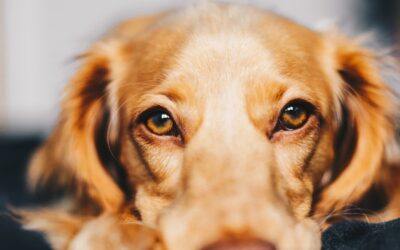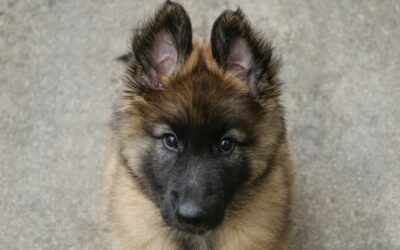It’s no secret that dogs love to lick. Whether it’s your face, their toys, or their own paws, licking is a common canine behavior. But if you’ve noticed your furry friend obsessively licking their paws, it might be more than just a harmless habit—especially if it’s becoming a constant or aggressive behavior.
If you’ve caught yourself asking, “Why is my dog licking his paws?” this blog is here to help. We’ll explore the common reasons dogs lick their paws, what excessive licking might indicate, and what steps you can take to help your pup stay healthy and comfortable.

What Does Paw Licking Mean?
The Self-Grooming Process
Licking is a natural part of a dog’s self-grooming routine. Much like cats, dogs use their tongue to clean dirt, debris, and other particles from their fur and paws. Occasional licking of the paws is entirely normal and is simply their way of maintaining hygiene.
However, it’s important to distinguish normal self-grooming from excessive licking. While the former is a healthy and instinctive behavior, the latter may indicate an underlying issue that needs attention.
Monitoring the frequency and intensity of your dog’s licking can help identify whether it is part of their grooming process or a sign of discomfort requiring intervention.

When Licking Becomes Excessive
However, when dogs lick their paws constantly or aggressively, it’s often a sign of discomfort or an underlying health issue. Frequent paw licking can lead to secondary infections, skin irritation, and even behavioral changes if left unchecked. It’s important to carefully inspect your dog’s paws to determine the possible cause.
The key to figuring out your dog’s behavior lies in understanding what’s triggering it. Below are some potential causes.
Common Reasons for Paw Licking in Dogs
1. Allergies
One of the most common reasons dogs lick their paws excessively is due to allergies. Allergies in dogs can be triggered by various factors, including environmental allergens like pollen, grass, or mold, as well as food allergens such as certain proteins, grains, or additives. When exposed to these allergens, dogs may experience itching and discomfort, particularly on their paws, leading them to lick as a way of soothing the irritation.
Additionally, contact with certain chemicals, like de-icing salts or cleaning products, can cause allergic reactions localized to the paws. If you suspect allergies are the cause of your dog’s paw licking, it’s essential to consult your veterinarian for accurate diagnosis and treatment options. Treatments may include allergy testing, dietary changes, medications, or topical solutions to provide relief and reduce excessive licking.
- Food Allergies: Ingredients in your dog’s diet, such as grains or certain proteins, can trigger an allergic reaction, leading to itchy skin and paws.
- Environmental Allergies: Pollen, mold, or dust mites can irritate your dog’s skin, causing itchy paws or frequent licking. This is especially common during certain seasons.
What to Do: If you suspect an allergic reaction, look for symptoms like swollen eyes, itchy skin, or a runny nose. Consult your veterinarian to identify allergens and provide appropriate treatment such as oral medications or dietary adjustments.
Skin Irritation and Yeast or Bacterial Infections
Another common cause of paw licking in dogs is skin irritation or infections caused by yeast or bacteria. When a dog’s paws come into contact with irritants, such as rough surfaces or harmful chemicals, tiny abrasions or cracks in the skin can occur. These openings create a perfect environment for yeast or bacteria to grow, leading to infections that cause discomfort, redness, swelling, and an unpleasant odor.
Dogs often lick their paws excessively in an attempt to alleviate this discomfort, which can unfortunately exacerbate the problem by spreading the infection or further irritating the skin.
- Yeast or Bacterial Infections: Dogs frequently lick their paws to soothe itchy spots caused by bacterial or yeast infections. These infections often have symptoms like redness, bad odor, or discoloration on the paw pads.
- Flea Allergy Dermatitis: Fleas can irritate your dog’s skin and paws, making them itch and lick constantly.
What to Do: Carefully inspect your dog’s paws for signs of redness, swelling, or unusual odors. Regular cleaning and topical treatments recommended by a vet can help address these issues.
3. Pain or Discomfort
Dogs lick their paws to manage pain or discomfort. Some common causes include:
- Ingrown Nails or Cuts
- Bee Stings or Splinters
- Arthritis or Joint Pain
If your dog is focusing on just one paw or appears to be limping, they might be experiencing localized pain. For injuries, keep a pet first aid kit handy and clean any cuts or splinters. For chronic conditions like arthritis, consult your vet about treatment options.
Behavioral Issues
Paw licking in dogs is not always due to physical ailments; behavioral issues can also play a significant role. Anxiety, stress, or boredom are common psychological factors that may lead a dog to lick its paws excessively as a coping mechanism.
For instance, dogs experiencing separation anxiety might engage in repetitive behaviors like paw licking to self-soothe. Similarly, a lack of mental stimulation or physical activity can lead to boredom, prompting a dog to create its own form of entertainment or distraction through licking.
- Separation Anxiety: Dogs dealing with long periods of separation from their owners might lick as a coping mechanism.
- Boredom: Lack of mental or physical stimulation can lead to compulsive behaviors, such as paw licking.
What to Do: Engage your dog with toys, regular exercise, and behavior modification techniques. If the licking behavior persists, working with an animal behaviorist or veterinary behaviorist can provide additional strategies.
5. Underlying Health Problems
Constant licking might also indicate more serious health concerns, such as:
- Immune System Disorders
- Itchy Throat or Swollen Eyes from General Allergies
- Secondary Skin Conditions from Prolonged Licking
Your dog’s excessive paw licking could build into secondary infections if left untreated—requiring more advanced care, such as oral medications or prescription topical treatments.

How to Address and Prevent Excessive Paw Licking
Inspect Your Dog’s Paws Regularly
Carefully inspect for small cuts, splinters, redness, swelling, or foreign objects. Sometimes, something as small as an ingrown nail can be the root cause.
Keep Your Dog’s Paws Clean
Wash your dog’s paws after walks using pet-friendly wipes to remove allergens or irritants like pollen or salt.
Provide Paw Protection
Consider using dog booties or balms to protect paw pads from harsh weather conditions, rough terrain, or harmful chemicals.
Consult Your Veterinarian
If aggressive licking or other dog behaviors persist, consult a vet to identify any underlying issues. Testing for bacterial infections or food allergies might reveal the root of the licking behavior.
Engage and Stimulate Your Dog’s Mind
Boredom-induced licking may disappear if your dog receives enough attention, exercise, and mental stimulation.
Use Appropriate Treatments
Your vet may recommend oral medications, topical treatments, or even adjustments to your dog’s diet depending on the underlying cause.
When to Seek Professional Help
If your dog is licking their paws excessively or showing signs of discomfort, such as limping or crying, seek veterinary care immediately. Problems like bacterial or yeast infections, allergic reactions, or serious injuries require prompt evaluation to prevent secondary infections or prolonged suffering.
Additionally, working with a veterinary behaviorist can be helpful if the issue stems from anxiety or other behavioral concerns.
Top 6 Products to Help with Excessive Paw Licking
Managing excessive paw licking in dogs often requires a combination of behavioral interventions and supportive products. Here are six top-rated products that can help alleviate this issue:
Zesty Paws Aller-Immune Supplement Chews
These tasty chews support your dog’s immune system and combat allergies, which can often cause itchy paws.
Paw Nectar Organic Paw Balm
A soothing, natural balm that moisturizes and heals dry, irritated paws. Perfect for dogs with cracked or inflamed paw pads.
Calming Hemp Oil for Dogs by Honest Paws
Ideal for dogs dealing with anxiety or stress-related licking, this hemp oil promotes relaxation and overall well-being.
Dog Recovery Cone (Soft E-Collar)
A comfortable alternative to the traditional cone, this product prevents your dog from licking their paws excessively while still allowing mobility.
Burt’s Bees Paw & Nose Lotion for Dogs
Made with natural ingredients, this lotion soothes and hydrates your dog’s paws, reducing irritation and itchiness.
KONG Classic Dog Toy
Providing mental stimulation and physical enrichment, this toy keeps your dog entertained, helping to prevent boredom-induced licking.
These products, when used alongside behavioral modifications and veterinarian advice, can help address the root causes of excessive paw licking, giving your dog a more comfortable and healthy life.

Stop by Snouts And Snouts Indoor Dog Park and Bar to let your dog play the day away!
Keep Your Furry Friend Happy and Healthy | Why Is My Dog Licking His Paws
Occasional paw licking in dogs is a natural behavior—but when it becomes excessive or constant, it’s time to take action. By understanding the common reasons behind your dog’s licking behavior and taking the right steps, you can keep their paws (and overall health) in top shape.
Whether it’s allergies, behavioral issues, or a health problem, your furry friend depends on you to carefully inspect their paws and ensure they’re comfortable. If you’re still wondering, “Why is my dog licking his paws?”, don’t hesitate to reach out to your vet for advice.
A healthy pup is a happy pup—and what’s better than sharing countless joyful moments with your best friend?



